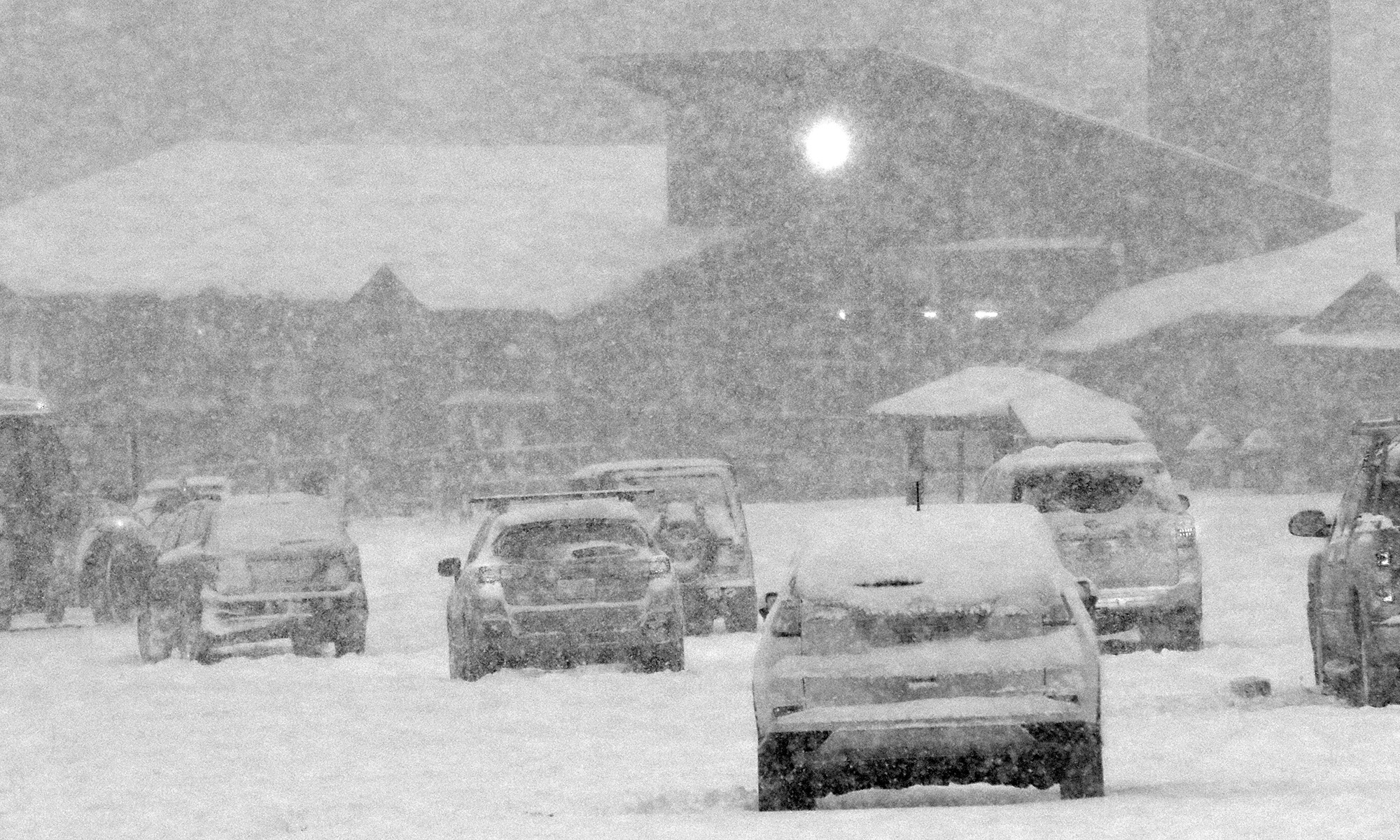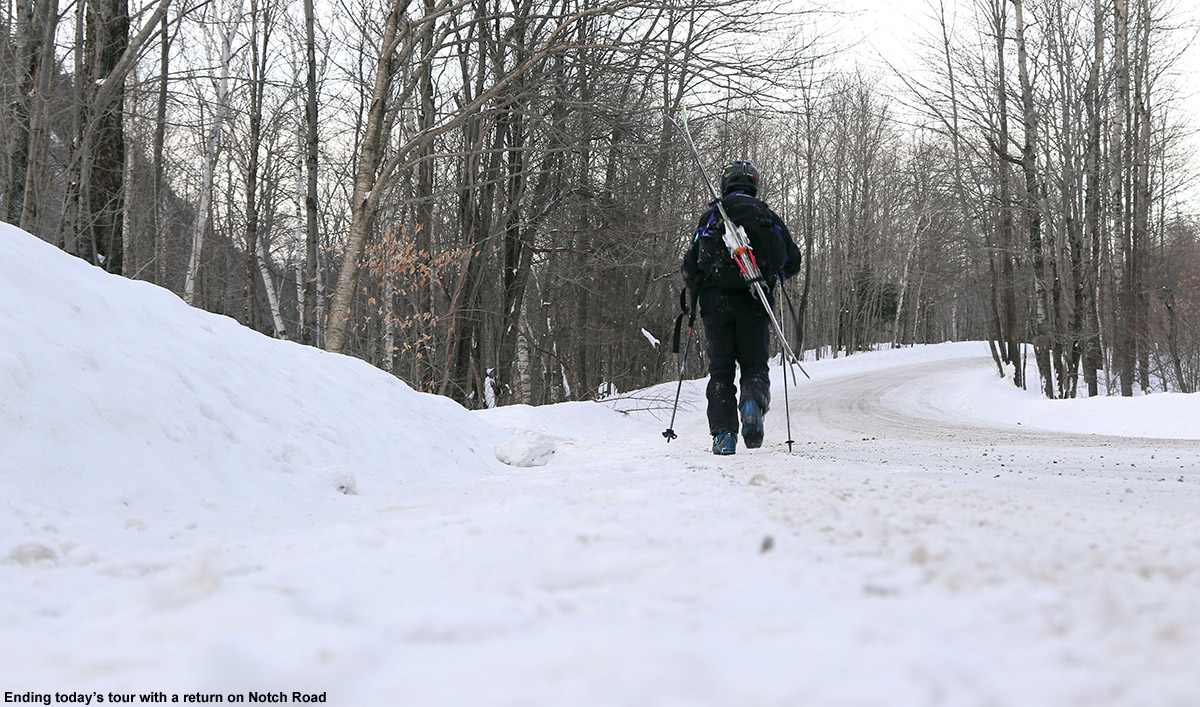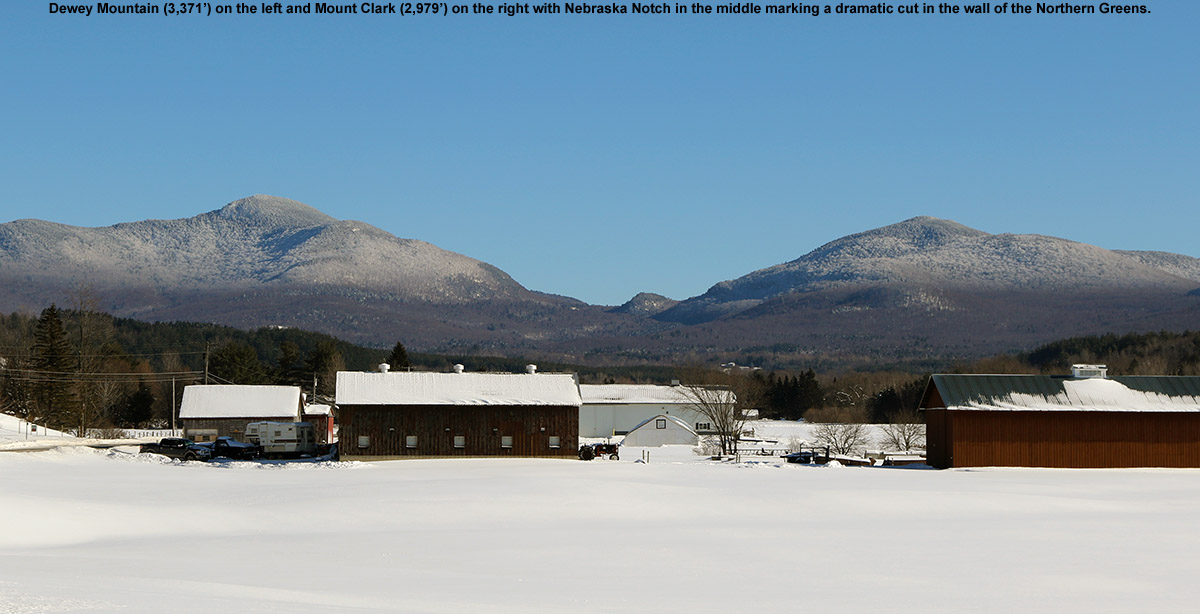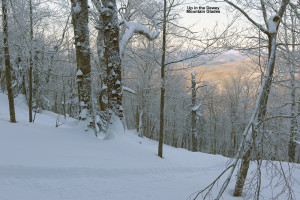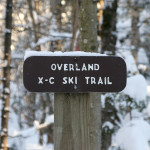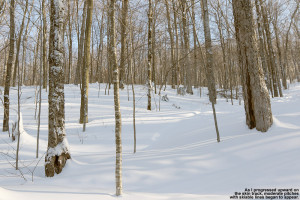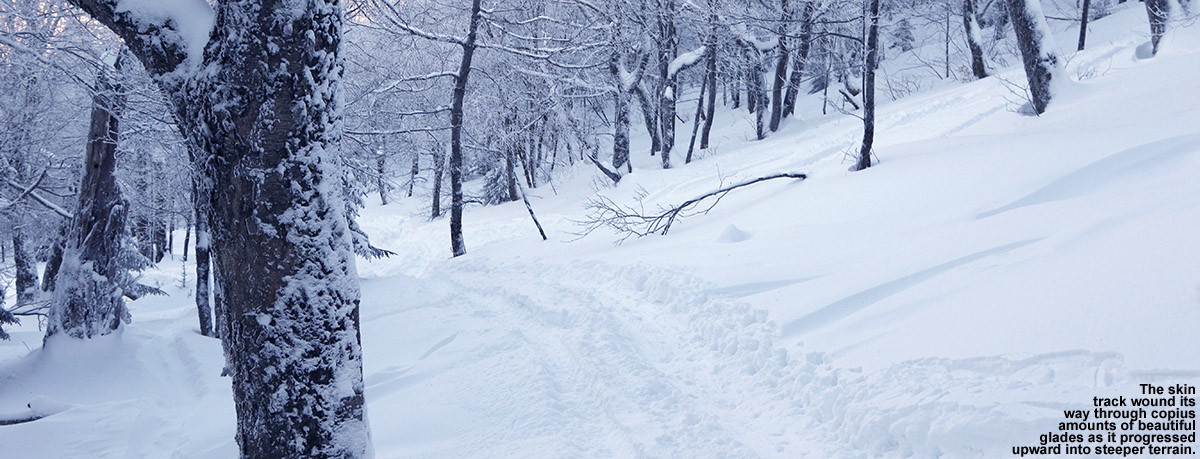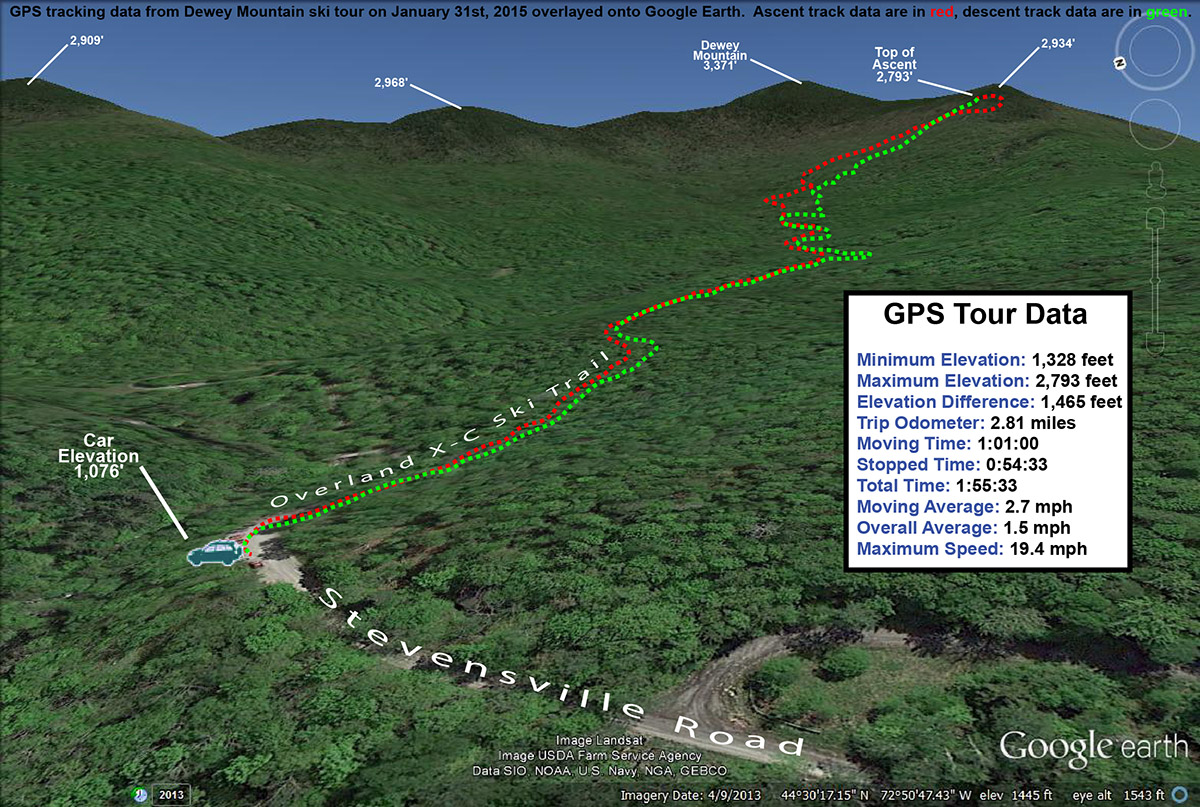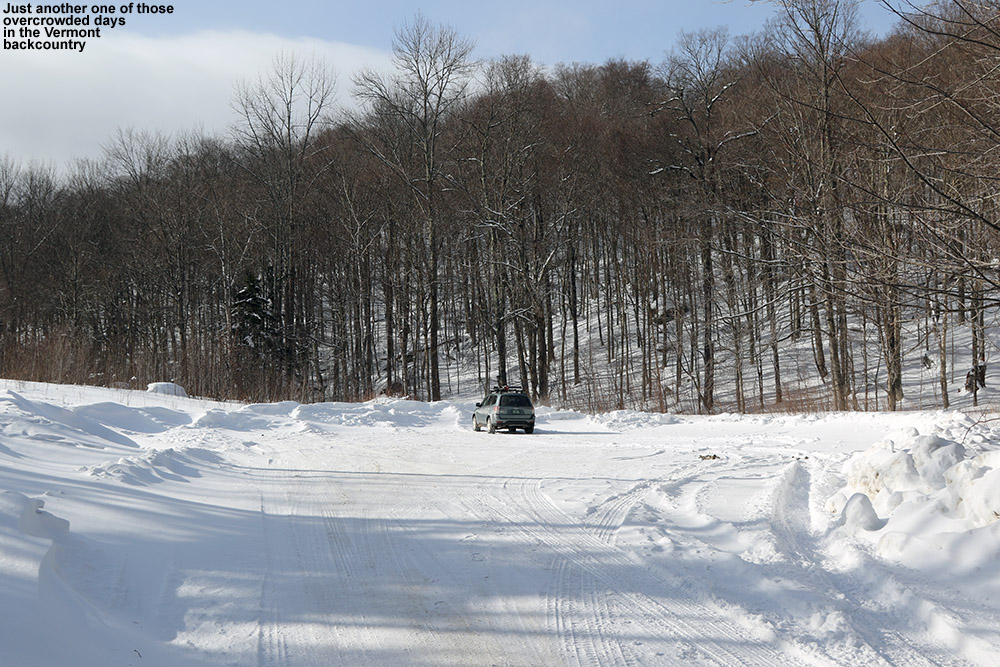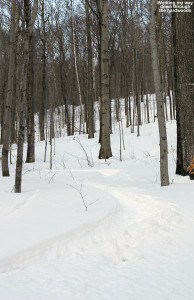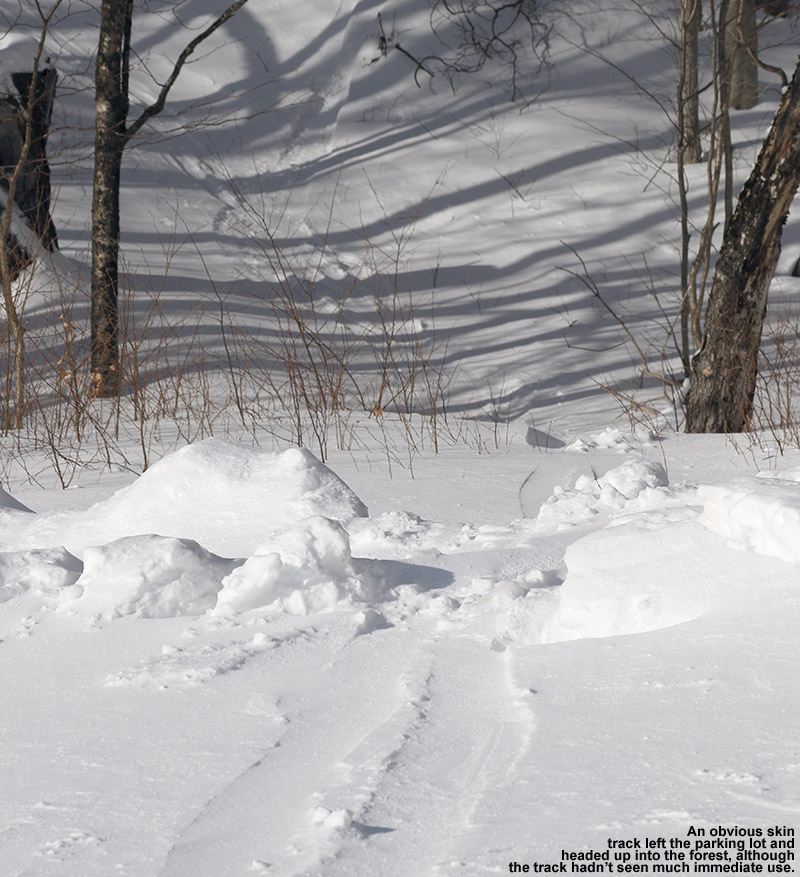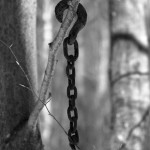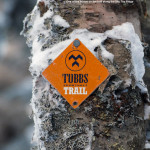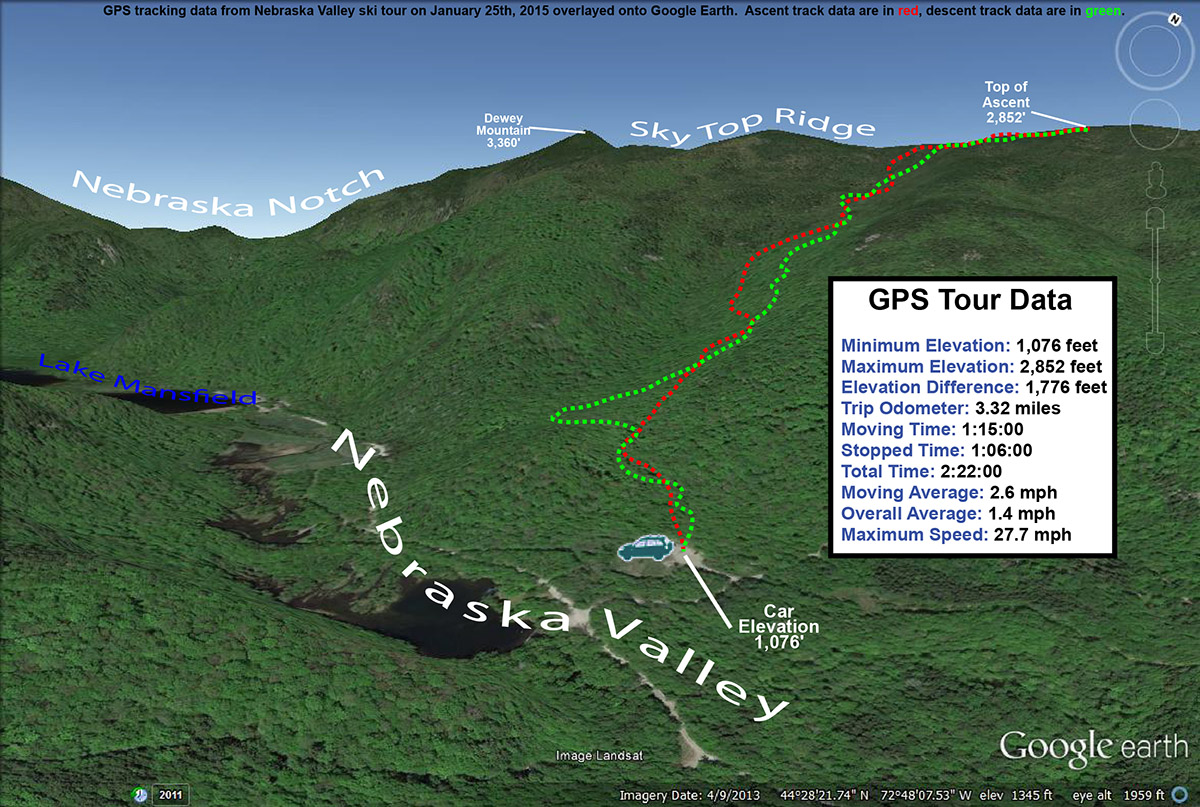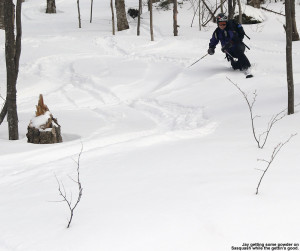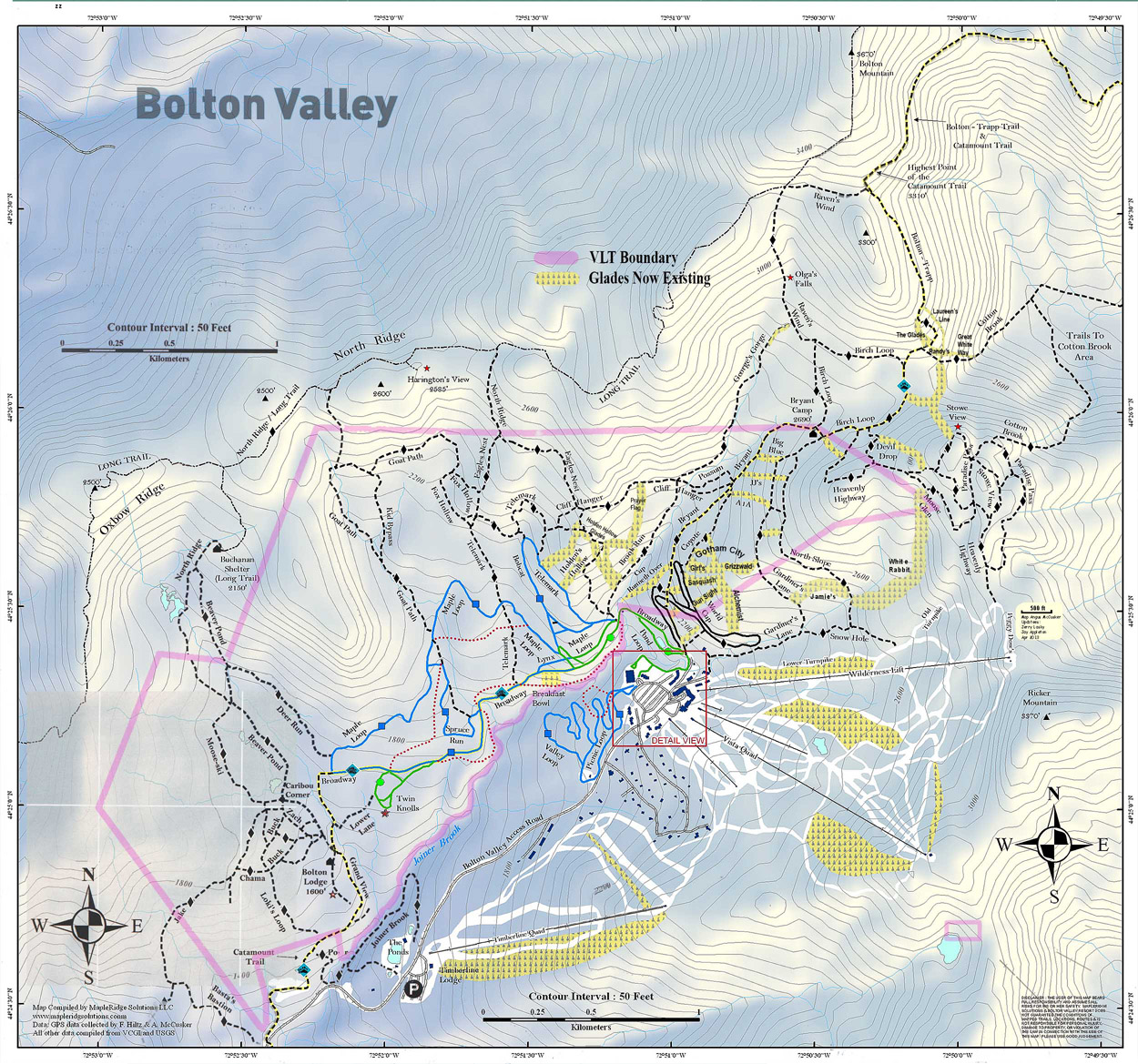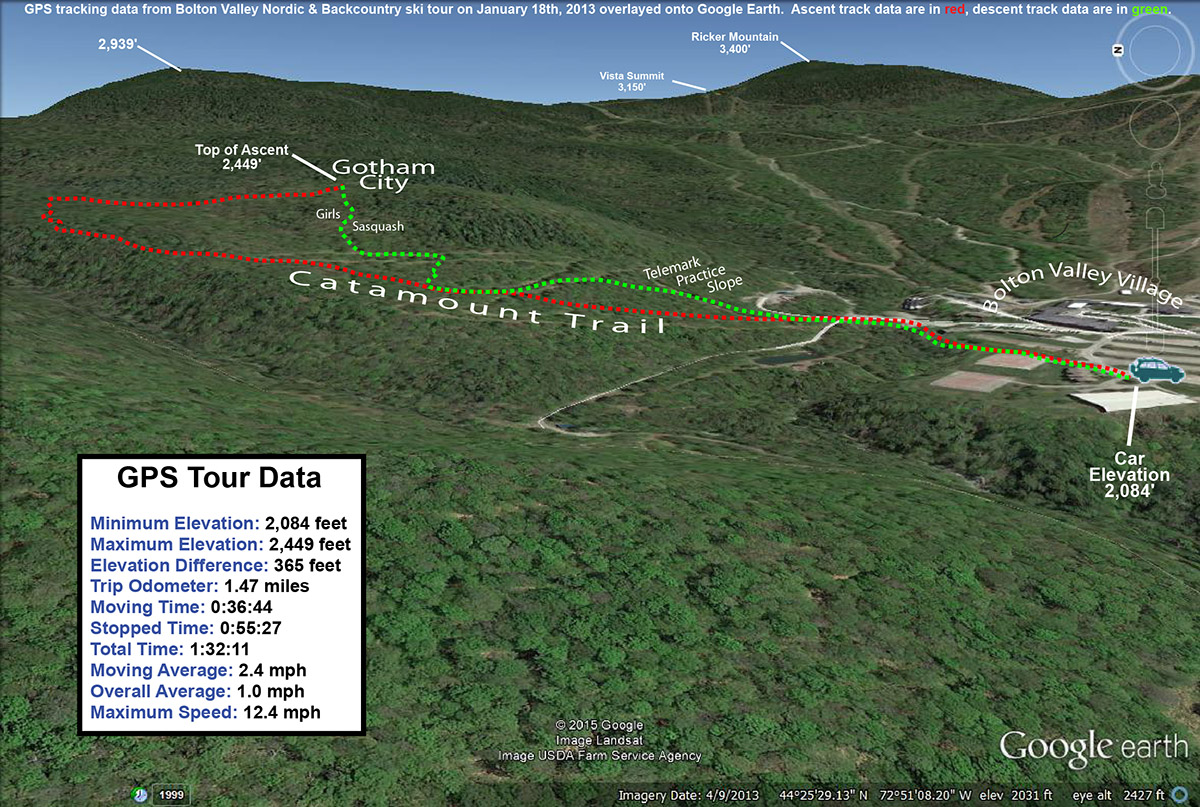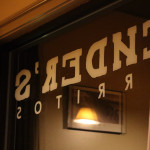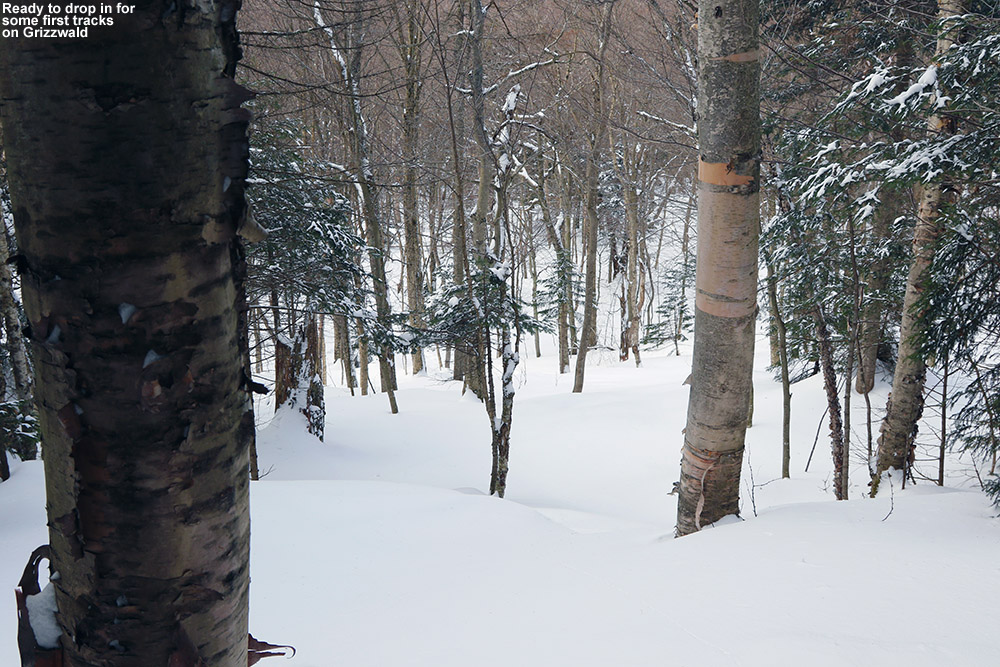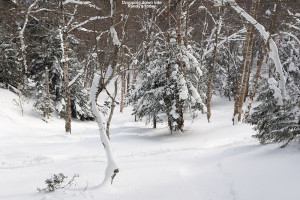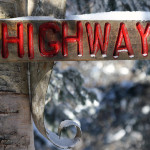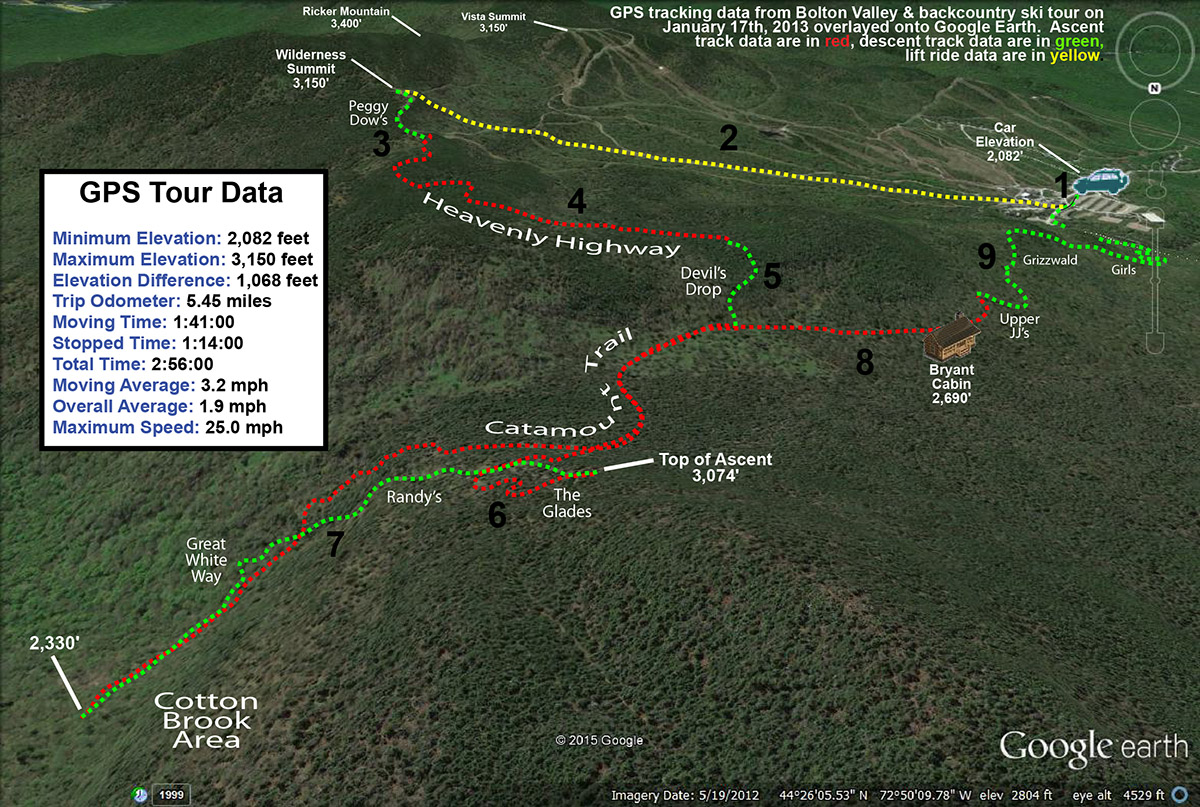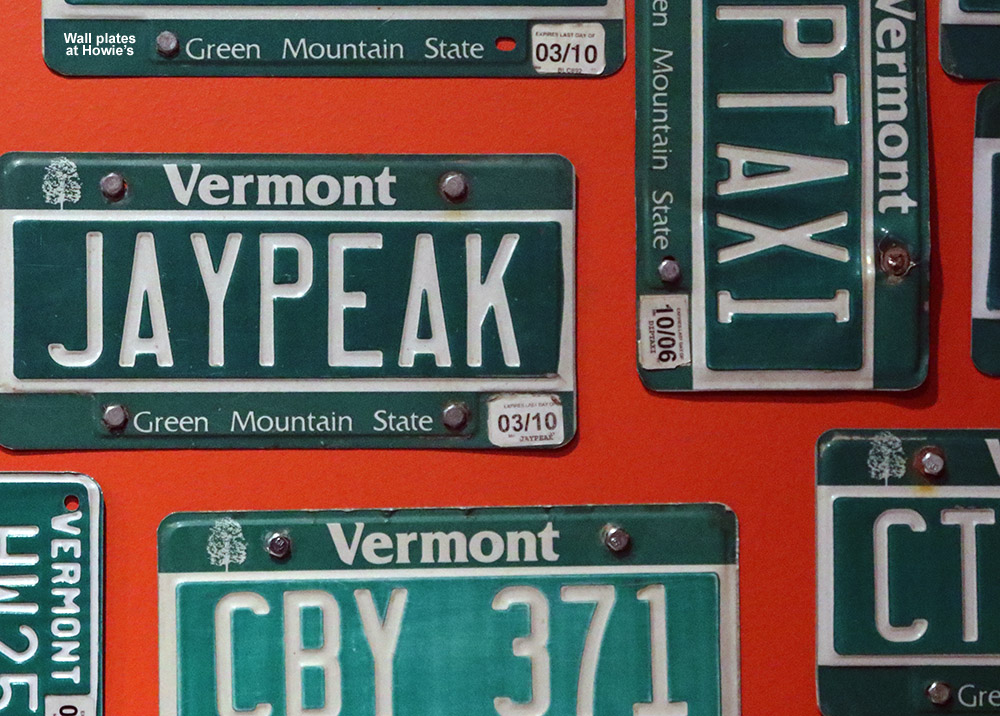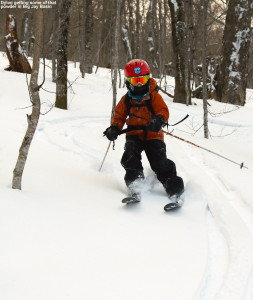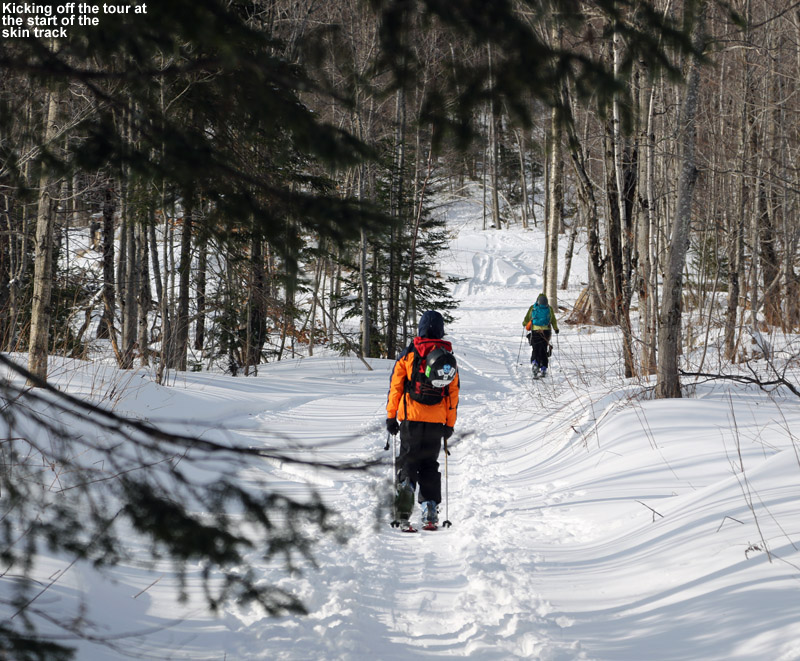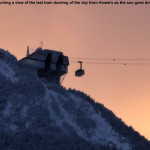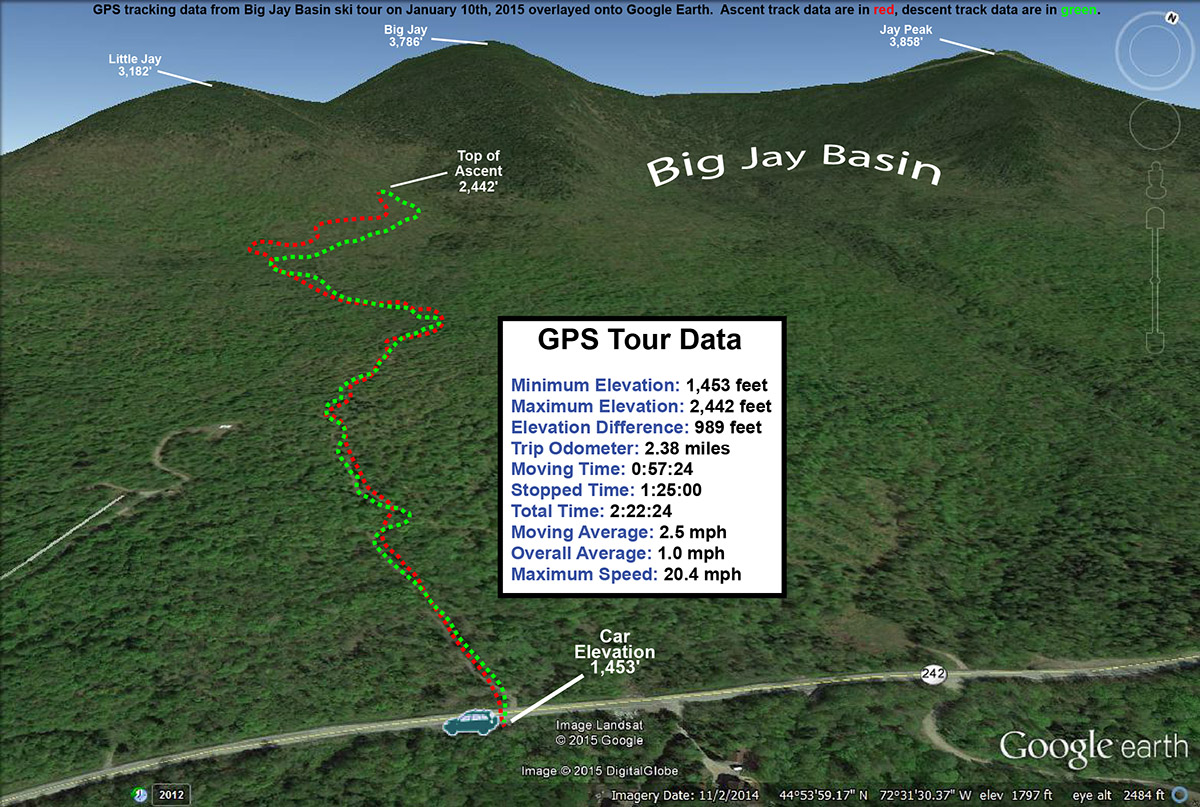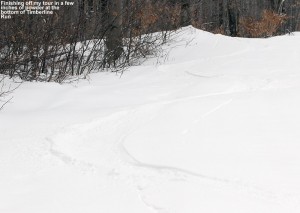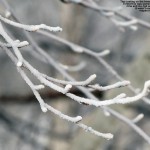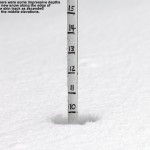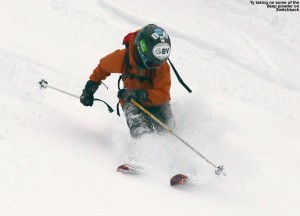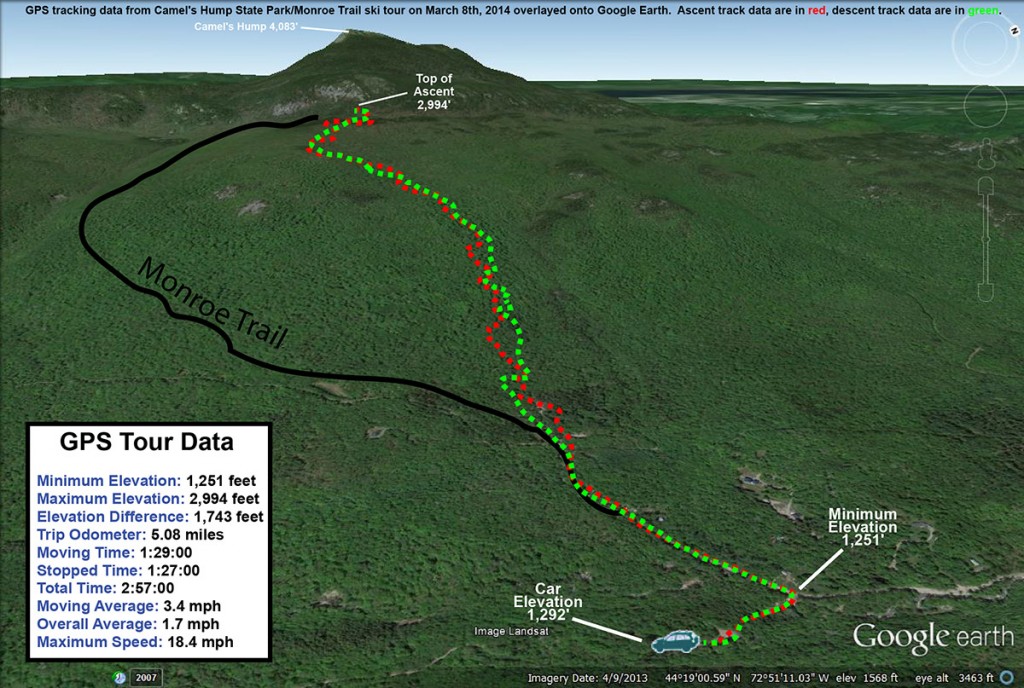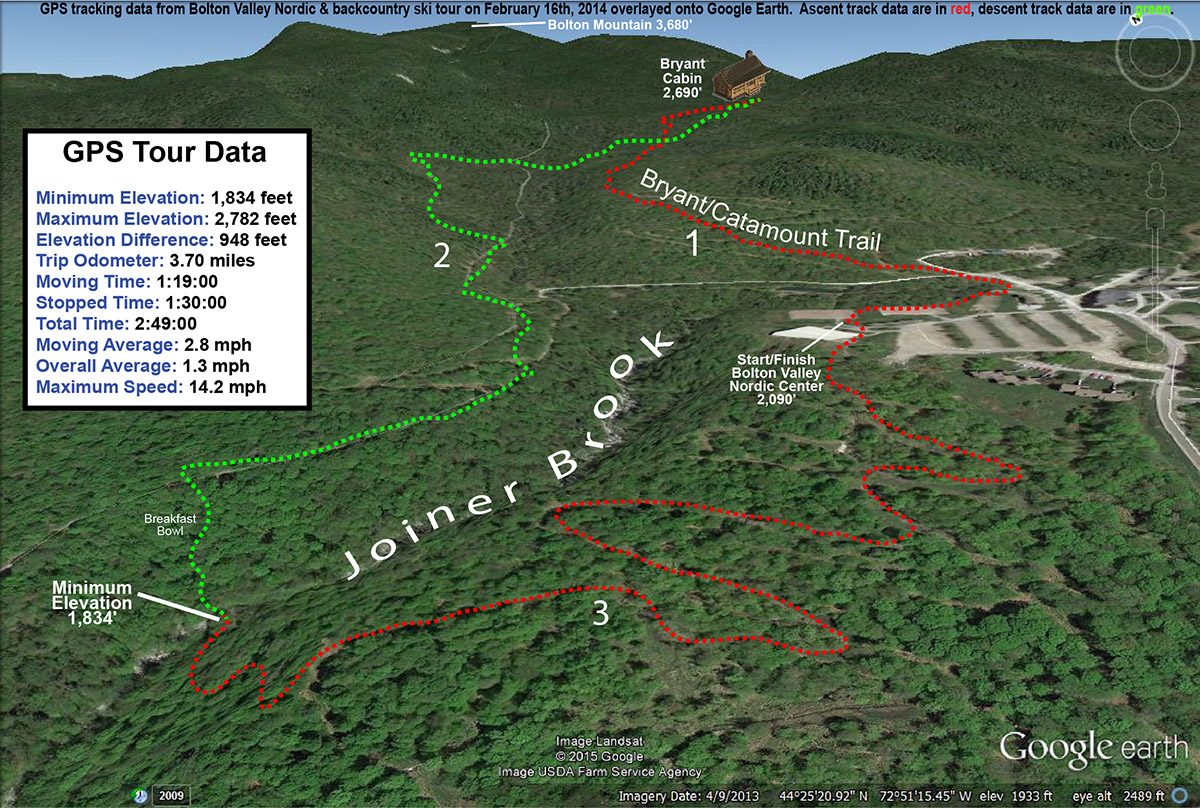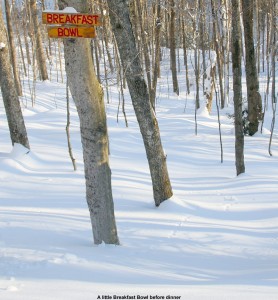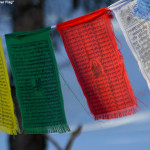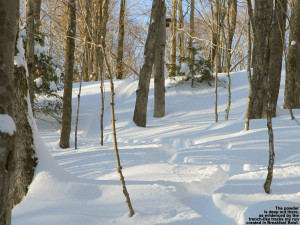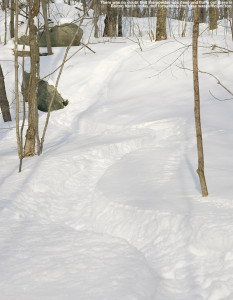
Relative to yesterday, today’s forecast called for temperatures to be a couple of degrees warmer, but the reality was that the cold arctic air would still be in place, and temperatures would likely be in the single digits F in the mountains. Add some breezes, and the wind chills would be well below zero, so it was an easy call for E and Claire to once again cancel our BJAMS ski program at Stowe. E and the boys were happy to stay inside out of the cold, but I figured I’d take the opportunity to get out for a workout and make some turns. It’s still weather that’s better suited for self-powered ascents vs. riding lifts as far as I’m concerned, so I made plans for another backcountry ski tour.
“…it was easier than breaking trail through the powder, which was already in the 12-15″ range.”
I figured I’d go with a fairly quick tour today, something a bit closer to home and with modest vertical. I was impressed with the snow I found yesterday on my Dewey Mountain ski tour, so I figured I could stick with some west side skiing, and the Bolton Notch area came to mind. I know there’s plenty of skiing on the eastern slopes of Bolton Notch, as I’ve heard about if from friends and colleagues that live there. Many people who live on the east side of Bolton Notch Road simply hike up from their back yards and ski back down. The ridgeline up above stretches from the Oxbow Ridge area and Bolton Notch Peak in the north, to Stimson Mountain in the south, and just as it marks the eastern wall of Bolton Notch, it represents the western wall of the Bolton Valley area. I’ve skied down from the ridge on the Bolton Valley side, and when I’ve been up there on the ridge, I’ve even heard people just down below me on the Bolton Notch side. I suspected the people I heard were backcountry skiers, and figured that at some point I’d pick a day to check out that side of the ridge.
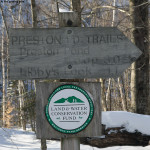 Although my preference was to explore the skiing options down below the ridge at the point where I’d heard people in the past, for my first exploration of the notch I planned to start a tour from wherever I found convenient parking. That turned out to be a couple miles north of where I was initially thinking, at the parking area for the Preston Pond Trails. The lot is at an elevation of ~1,200′ on the west side of the road, and although it’s fairly small and already had another car in it, there was plenty of room for another. So I’d found decent parking, but in reality, I wasn’t all that optimistic about the potential for skiing in that area. The terrain directly to my east featured the huge cliffs of Bolton Notch Peak looming over everything, and they were cliffs that were essentially sheer and unskiable. And as if that wasn’t enough, the terrain below the cliffs was fairly steep and littered with car to house size boulders, presumably large chunks of rock that had fallen from the cliffs above. The prospects for skiing looked much better about a quarter mile to the south, where the terrain was a bit mellower and not so full of boulders. For my first visit to the area though, my plan was to just look for a skin track and see where it led me.
Although my preference was to explore the skiing options down below the ridge at the point where I’d heard people in the past, for my first exploration of the notch I planned to start a tour from wherever I found convenient parking. That turned out to be a couple miles north of where I was initially thinking, at the parking area for the Preston Pond Trails. The lot is at an elevation of ~1,200′ on the west side of the road, and although it’s fairly small and already had another car in it, there was plenty of room for another. So I’d found decent parking, but in reality, I wasn’t all that optimistic about the potential for skiing in that area. The terrain directly to my east featured the huge cliffs of Bolton Notch Peak looming over everything, and they were cliffs that were essentially sheer and unskiable. And as if that wasn’t enough, the terrain below the cliffs was fairly steep and littered with car to house size boulders, presumably large chunks of rock that had fallen from the cliffs above. The prospects for skiing looked much better about a quarter mile to the south, where the terrain was a bit mellower and not so full of boulders. For my first visit to the area though, my plan was to just look for a skin track and see where it led me.
“The depth of the surface powder snow was actually getting pretty close to yesterday’s depths at times, up into the range of 18″ or more, but these elevations just didn’t have as substantial a base.”
As has been the case as of late, temperatures were in the single digits, so I quickly geared up and set out. Right across the road, I saw ski tracks heading up into the trees, so I figured that must be the standard skin track for the parking area and hopped on. Well, it didn’t turn out to be a well-established skin track, it was just a skin track made by one or two previous skiers, and it left a lot to be desired. I’m not sure what they person who made it was thinking, but they set it with some steep pitches and cruxes that required scrambling or holding onto trees to get up and through. It seemed to be heading up toward the unskiable terrain of the cliffs, and since it was rather poorly placed, I thought more than once about simply breaking off on my own to the south and contouring up in elevation more slowly. But, I stuck with the skin track because even though it was poorly done, it was easier than breaking trail through the powder, which was already in the 12-15″ range.
“The ski terrain wasn’t looking more promising in any direction – to the north it was cliffs and boulders, and to the south it was getting too flat.”
Finally, at around 1,700′, the skin track intersected with the VAST trail that runs through the notch area, and the prospects for getting to some decent skiing were looking a little better. The person who’d made the track appeared to have headed off to the south on the VAST trail, and this was good because this was the direction toward what looked like much better ski terrain. I headed up a rise on the VAST trail, and kept my eyes peeled for signs of the skin track heading back into the trees. Indeed after a few hundred feet, I saw the skin track head off to the left on what looked like an old logging road. The ski touring potential there were looking good, but after about five to ten minutes of additional skinning, it was becoming obvious that the skin track wasn’t really heading toward any primo ski terrain. It followed the logging roads in the area and was generally quite nice in terms of pitch, but it soon looked like whoever had made the track had descended right back down it. I gave it a few more minutes until I saw that the track’s creator clearly didn’t know where they were going. There were small side loops in the track and signs of doubling back where the person seemed to be surveilling the area. After some of these small loops, I could see that the person did eventually continue onward, but at an elevation of a bit below 2,000′ I decided to call it. The ski terrain wasn’t looking more promising in any direction – to the north it was cliffs and boulders, and to the south it was getting too flat. I’d already seen some options for turns near where I was, which actually might be the local sweet spot for ski potential in that immediate area.
“There were some nice open hardwoods in there, and I got some great powder turns.”
I had some soup, switched over for the descent, and began my way back down in the area of the skin track. I was able to veer off the track and get into some nice terrain for powder turns that would eventually return me safely to the track. It was my first chance to actually check out how the snow was skiing, and I was a little leery because the snow down at these elevations wasn’t as deep as what I’d been in yesterday up on Dewey Mountain. The depth of the surface powder snow was actually getting pretty close to yesterday’s depths at times, up into the range of 18″ or more, but these elevations just didn’t have as substantial a base. When I actually got turning though, I found that the overall combination of powder and base was more than sufficient, especially floating on 115 mm fat skis. And I have to say that the fluff there in the notch was of really high quality – definitely up to the standards of Champlain Powder™.
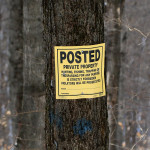 When I got back down to the VAST trail I decided that for the rest of the descent, I wasn’t going to go near the boulder-infested area in which I’d skinned up if I could help it. I opted to drop right from the VAST trail to Notch Road, or at least as straight down as the terrain and private property boundaries would let me. There were some nice open hardwoods in there, and I got some great powder turns. I had to navigate some ledges, but a shuffle to the left or right would usually get me to a mellower line around them. Unfortunately my direct descent was stopped when I ran into a “POSTED – PRIVATE PROPERTY” sign that belonged to one of the property owners below. I had to traverse above it, so I chose to go northward in the direction of the parking area. After a few minutes of traversing and skiing some lines, I saw that I’d soon be getting onto the property of a couple of additional houses, and fortunately, I found a nice area in between that seemed to be out of sight and off anyone’s property. That shot brought me right down to the road, where I strapped my skis on my pack and made the short walk back to my car.
When I got back down to the VAST trail I decided that for the rest of the descent, I wasn’t going to go near the boulder-infested area in which I’d skinned up if I could help it. I opted to drop right from the VAST trail to Notch Road, or at least as straight down as the terrain and private property boundaries would let me. There were some nice open hardwoods in there, and I got some great powder turns. I had to navigate some ledges, but a shuffle to the left or right would usually get me to a mellower line around them. Unfortunately my direct descent was stopped when I ran into a “POSTED – PRIVATE PROPERTY” sign that belonged to one of the property owners below. I had to traverse above it, so I chose to go northward in the direction of the parking area. After a few minutes of traversing and skiing some lines, I saw that I’d soon be getting onto the property of a couple of additional houses, and fortunately, I found a nice area in between that seemed to be out of sight and off anyone’s property. That shot brought me right down to the road, where I strapped my skis on my pack and made the short walk back to my car.
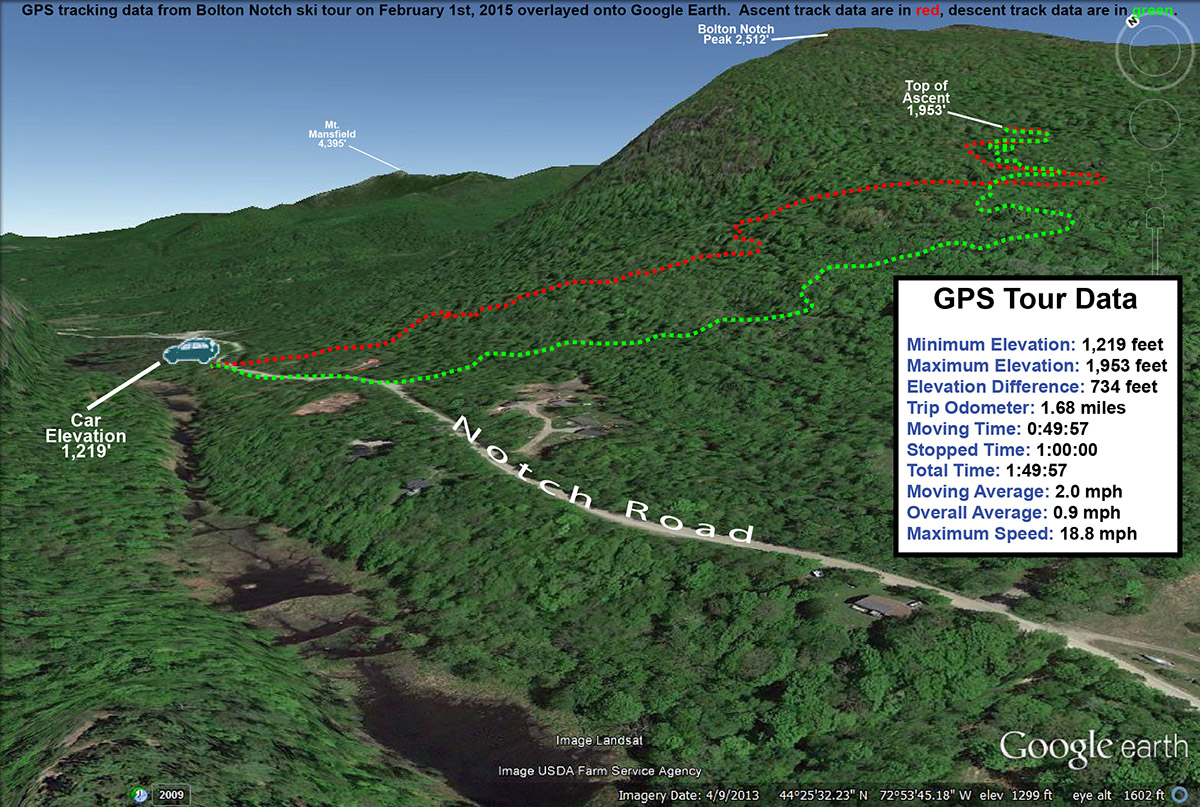
While I was packing up at the car, the owner of the other vehicle arrived with her dog. She actually lives right on the road, and we began to talk skiing. She asked how it was, and I said that the snow was great, but the ski terrain, as I’d expected, was somewhat limited. Between the cliffs up above, areas of terrain that were too flat, areas of terrain that were of inconsistent slope and alternated between ledges and run outs, and the private property boundaries, it just wasn’t a prime backcountry ski spot. There were some very nice lines with open trees, but overall it wasn’t a lot of bang for your buck. I inquired about other parking areas on the road, and she couldn’t think of any immediately, but suggested to go to the Long Trail area. She said that once you got up above the VAST trail in that area, there were some nice lines. That is indeed back where I’d initially thought I’d find some good terrain, so I’ll likely try to find my way over there at some point in the future.
